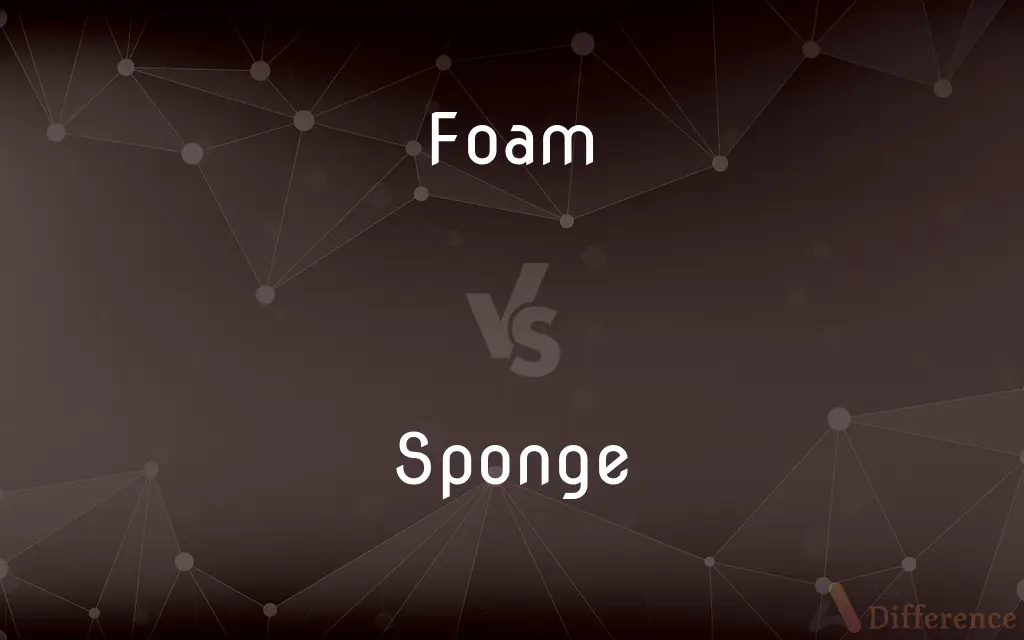Foam vs. Sponge — What's the Difference?
By Urooj Arif & Fiza Rafique — Updated on April 4, 2024
Foam is a substance formed from many gas bubbles trapped in a liquid or solid, often light and soft, while sponge is a porous material, either synthetic or natural, known for absorbency and used for cleaning or padding.

Difference Between Foam and Sponge
Table of Contents
ADVERTISEMENT
Key Differences
Foam can be created by trapping pockets of gas in a liquid or solid, making it lightweight and capable of providing cushioning. This property makes foam ideal for applications such as insulation, padding in furniture, and even in personal care products like shaving cream. On the other hand, a sponge is characterized by its porous structure, which allows it to absorb and hold liquids effectively. This makes sponges a popular choice for cleaning tasks, from washing dishes to wiping down surfaces.
The material composition of foam varies widely, from polyurethane in furniture to polystyrene in disposable coffee cups. These materials contribute to foam's versatility in both industrial and consumer products. Conversely, sponges can be made from natural materials, such as cellulose or the skeletons of sea creatures, as well as from synthetic materials like plastic. The source of a sponge often determines its texture, density, and best use case.
Foam's structure can be engineered to specific densities and firmness, affecting its compressibility and resilience. This customization allows foam to serve in various capacities, from soft memory foam mattresses that contour to the body to rigid insulation foams used in construction. Sponges, while also available in a range of densities, primarily excel in tasks requiring absorbency and gentle abrasion, such as personal hygiene products or car washing tools.
Both foam and sponge face scrutiny. Foam products, especially those designed for single use, can contribute significantly to pollution due to their non-biodegradable nature. Natural sponges, while biodegradable, require careful harvesting to prevent ecosystem damage. Synthetic sponges offer a reusable alternative but can also contribute to microplastic pollution.
In terms of care and maintenance, foam often requires specific care, such as avoiding excessive moisture that can degrade certain types of foam. Sponges, while easy to clean, can harbor bacteria and require regular disinfection or replacement to ensure hygiene, especially in kitchen settings.
ADVERTISEMENT
Comparison Chart
Composition
Can be made from various materials, including polyurethane, polystyrene.
Made from natural cellulose, synthetic materials, or sea sponges.
Texture
Varies widely from soft and compressible to rigid.
Porous, ranging from soft to mildly abrasive.
Primary Use
Insulation, padding, personal care products.
Cleaning, absorbency, personal hygiene.
Absorbency
Varies, not primarily designed for absorbency.
High, designed to absorb and hold liquids.
Environmental Impact
Non-biodegradable types contribute to pollution.
Natural types are biodegradable but can affect ecosystems; synthetic types contribute to microplastic pollution.
Compare with Definitions
Foam
A mass of small bubbles formed in or on a liquid.
Foam formed on the top of the beer.
Sponge
A tool used in painting to create textured effects.
He used a sponge to dab paint onto the canvas for a mottled effect.
Foam
A soft, cushioned material used in various products.
The mattress is made of memory foam for comfort.
Sponge
A soft, porous rubber or plastic material used for padding.
The packaging was protected with a layer of sponge foam.
Foam
A frothy substance in personal care products.
He applied shaving foam before starting to shave.
Sponge
A porous material used for absorbing liquids and cleaning.
She cleaned the spill with a kitchen sponge.
Foam
A lightweight material used in crafting and floral arrangements.
She used floral foam to create the centerpiece.
Sponge
A metaphor for someone who absorbs information easily.
As a student, she was a sponge, soaking up every word.
Foam
A substance used for insulation or in protective packaging.
The walls were insulated with spray foam.
Sponge
A natural organism from the ocean, known for its absorbent skeleton.
Natural sea sponges are harvested for bathing.
Foam
Foam is an object formed by trapping pockets of gas in a liquid or solid.A bath sponge and the head on a glass of beer are examples of foams. In most foams, the volume of gas is large, with thin films of liquid or solid separating the regions of gas.
Sponge
Sponges, the members of the phylum Porifera (; meaning 'pore bearer'), are a basal animal clade as a sister of the Diploblasts. They are multicellular organisms that have bodies full of pores and channels allowing water to circulate through them, consisting of jelly-like mesohyl sandwiched between two thin layers of cells.
Foam
A mass of small bubbles formed on or in liquid, typically by agitation or fermentation
A beer with a thick head of foam
Sponge
Any of numerous aquatic, chiefly marine filter-feeding invertebrate animals of the phylum Porifera, characteristically having a porous skeleton composed of fibrous material or siliceous or calcareous spicules and often forming colonies attached to an underwater surface. Also called poriferan.
Foam
Form or produce a mass of small bubbles; froth
The sea foamed beneath them
Sponge
A piece of the absorbent skeleton of certain of these organisms, or a piece of plastic or another material that is similar in absorbency, used for cleaning, bathing, and other purposes.
Foam
A colloidal dispersion of a gas in a liquid or solid medium, such as shaving cream, foam rubber, or a substance used to fight fires. A foam may be produced, especially on the surface of a liquid, by agitation or by a chemical reaction, such as fermentation.
Sponge
Metal in a porous, brittle form, as after the removal of other metals in processing, used as a raw material in manufacturing.
Foam
Any of various light, porous, semirigid or spongy materials, usually the solidified form of a liquid full of gas bubbles, used as a building material or for thermal insulation or shock absorption, as in packaging.
Sponge
Dough that has been or is being leavened.
Foam
Frothy saliva produced especially as a result of physical exertion or a pathological condition.
Sponge
A light cake, such as sponge cake.
Foam
The frothy sweat of a horse or other equine animal.
Sponge
(Informal) One who habitually depends on others for one's own maintenance.
Foam
The sea.
Sponge
(Slang) A person who drinks large amounts of alcohol.
Foam
To produce or issue as foam; froth.
Sponge
To moisten, wipe, or clean with a sponge or cloth
Sponge off the table.
Foam
To produce foam from the mouth, as from exertion or a pathological condition.
Sponge
To remove or absorb with a sponge or cloth
Sponge off the sweat.
Sponge up the mess.
Foam
To be extremely angry; rage
Was foaming over the disastrous budget cuts.
Sponge
To apply or daub with a sponge
Sponge paint on the wall.
Foam
To teem; seethe
A playground foaming with third graders.
Sponge
(Informal) To obtain free, as by begging or freeloading
Sponge a meal.
Foam
To cause to produce foam.
Sponge
To harvest sponges.
Foam
To cause to become foam.
Sponge
(Informal) To obtain something such as food or money by relying on the generosity of others
Sponged off her parents.
Foam
A substance composed of a large collection of bubbles or their solidified remains, especially:
Sponge
(countable) Any of various marine invertebrates of the phylum Porifera, that have a porous skeleton often of silica.
Foam
A collection of small bubbles created when the surface of a body of water is moved by tides, wind, etc.
Sponge
(countable) A piece of porous material used for washing (originally made from the invertebrates, now often made of plastic).
Foam
A collection of small bubbles formed from bodily fluids such as saliva or sweat.
Sponge
(uncountable) A porous material such as sponges consist of.
Foam
A collection of small bubbles on the surface of a liquid that is heated, fermented or carbonated.
Sponge
(informal) A heavy drinker.
Foam
A collection of small bubbles created by mixing soap with water.
Sponge
A type of light cake.
Foam
(firefighting) A collection of small bubbles formed by mixing an extinguishing agent with water, used to cover and extinguish fires.
Sponge
A type of steamed pudding.
Foam
A material formed by trapping pockets of gas in a liquid or solid.
A foam mat can soften a hard seat.
Sponge
(slang) A person who takes advantage of the generosity of others (abstractly imagined to absorb or soak up the money or efforts of others like a sponge).
Foam
The sea.
He is in Europe, across the foam.
Sponge
A person who readily absorbs ideas.
Foam
Fury.
Sponge
Any sponge-like substance.
Foam
(intransitive) To form or emit foam.
Sponge
(baking) Dough before it is kneaded and formed into loaves, and after it is converted into a light, spongy mass by the agency of the yeast or leaven.
Foam
(intransitive) To spew saliva as foam; to foam at the mouth.
Sponge
Iron from the puddling furnace, in a pasty condition.
Foam
(firefighting) To coat or cover with foam.
It used to be common practice to foam the runway prior to an emergency landing, in case a fuel-fed fire occurred.
Sponge
Iron ore, in masses, reduced but not melted or worked.
Foam
The white substance, consisting of an aggregation of bubbles, which is formed on the surface of liquids, or in the mouth of an animal, by violent agitation or fermentation; froth; spume; scum; as, the foam of the sea.
Sponge
A mop for cleaning the bore of a cannon after a discharge. It consists of a cylinder of wood, covered with sheepskin with the wool on, or cloth with a heavy looped nap, and having a handle, or staff.
Foam
To gather foam; to froth; as, the billows foam.
He foameth, and gnasheth with his teeth.
Sponge
The extremity, or point, of a horseshoe, corresponding to the heel.
Foam
To form foam, or become filled with foam; - said of a steam boiler when the water is unduly agitated and frothy, as because of chemical action.
Sponge
(slang) A nuclear power plant worker routinely exposed to radiation.
Foam
To cause to foam; as, to foam the goblet; also (with out), to throw out with rage or violence, as foam.
Sponge
To take advantage of the kindness of others.
He has been sponging off his friends for a month now.
Foam
A mass of small bubbles formed in or on a liquid
Sponge
To get by imposition; to scrounge.
To sponge a breakfast
Foam
A lightweight material in cellular form; made by introducing gas bubbles during manufacture
Sponge
(transitive) To deprive (somebody) of something by imposition.
Foam
Form bubbles;
The boiling soup was frothing
The river was foaming
Sparkling water
Sponge
To clean, soak up, or dab with a sponge.
Sponge
To suck in, or imbibe, like a sponge.
Sponge
To wipe out with a sponge, as letters or writing; to efface; to destroy all trace of.
Sponge
To be converted, as dough, into a light, spongy mass by the agency of yeast or leaven.
Sponge
To use a piece of wild sponge as a tool when foraging for food.
Sponge
Any one of numerous species of Spongiæ, or Porifera. See Illust. and Note under Spongiæ.
Sponge
The elastic fibrous skeleton of many species of horny Spongiæ (Keratosa), used for many purposes, especially the varieties of the genus Spongia. The most valuable sponges are found in the Mediterranean and the Red Sea, and on the coasts of Florida and the West Indies.
Sponge
One who lives upon others; a pertinacious and indolent dependent; a parasite; a sponger.
Sponge
Any spongelike substance.
Sponge
A mop for cleaning the bore of a cannon after a discharge. It consists of a cylinder of wood, covered with sheepskin with the wool on, or cloth with a heavy looped nap, and having a handle, or staff.
Sponge
The extremity, or point, of a horseshoe, answering to the heel.
Sponge
To cleanse or wipe with a sponge; as, to sponge a slate or a cannon; to wet with a sponge; as, to sponge cloth.
Sponge
To wipe out with a sponge, as letters or writing; to efface; to destroy all trace of.
Sponge
Fig.: To deprive of something by imposition.
Sponge
Fig.: To get by imposition or mean arts without cost; as, to sponge a breakfast.
Sponge
To suck in, or imbibe, as a sponge.
Sponge
Fig.: To gain by mean arts, by intrusion, or hanging on; as, an idler sponges on his neighbor.
The fly is an intruder, and a common smell-feast, that sponges upon other people's trenchers.
Sponge
To be converted, as dough, into a light, spongy mass by the agency of yeast, or leaven.
Sponge
A porous mass of interlacing fibers the forms the internal skeleton of various marine animals and usable to absorb water or any porous rubber or cellulose product similarly used
Sponge
Someone able to acquire new knowledge and skills rapidly and easily;
She soaks up foreign languages like a sponge
Sponge
A follower who hangs around a host (without benefit to the host) in hope of gain or advantage
Sponge
Primitive multicellular marine animal whose porous body is supported by a fibrous skeletal framework; usually occurs in sessile colonies
Sponge
Wipe with a sponge, so as to clean or moisten
Sponge
Ask for and get free; be a parasite
Sponge
Erase with a sponge; as of words on a blackboard
Sponge
Soak up with a sponge
Sponge
Gather sponges, in the ocean
Common Curiosities
Are natural sponges better than synthetic ones?
Natural sponges are more eco-friendly and durable, but synthetic sponges are cheaper and available in a wider range of textures for different uses.
Are all foams synthetic?
While many foams are synthetic, there are also natural foams, such as those formed from soap or protein solutions.
How do I clean a sponge to prevent bacteria growth?
Disinfect sponges regularly by microwaving them wet for 2 minutes or using bleach solutions, and replace them frequently.
Can foam be recycled?
Certain types of foam, like some polystyrene foams, can be recycled, but recycling facilities vary by location.
How often should I replace my kitchen sponge?
Kitchen sponges should be replaced every 1-2 weeks, depending on use and cleaning method, to prevent bacterial growth.
Can foam absorb water like a sponge?
Some types of foam can absorb water, but sponges are specifically designed for high absorbency.
Is it safe to use foam containers for hot food?
Some foam containers can release harmful chemicals with hot foods; it's important to use food-grade, heat-resistant foam containers.
Can I use a sponge for applying makeup?
Yes, specially designed makeup sponges are excellent for applying and blending foundation and other products.
How long does a foam mattress last compared to a traditional mattress?
Foam mattresses can last up to 10 years or more with proper care, comparable to many traditional mattresses.
Can I compost a natural sponge?
Yes, natural sponges are biodegradable and can be composted, unlike synthetic sponges.
Can I use a sponge to clean electronics?
It's best to use a dry, soft sponge or a microfiber cloth for electronics to avoid moisture damage.
Are foam pillows good for neck pain?
Memory foam pillows can offer good support for the neck, potentially reducing pain by maintaining proper alignment.
What makes a sponge abrasive?
The texture and material composition of a sponge determine its abrasiveness, with some designed for gentle cleaning and others for scrubbing tough grime.
How is foam used in construction?
Foam is used for insulation, soundproofing, and in lightweight concrete formulations in construction.
What's the difference between shaving foam and shaving gel?
Shaving foam is airier and lighter, while shaving gel is denser and can provide a more lubricated shave.
Share Your Discovery

Previous Comparison
House vs. Cottage
Next Comparison
Sophisticated vs. IntelligentAuthor Spotlight
Written by
Urooj ArifUrooj is a skilled content writer at Ask Difference, known for her exceptional ability to simplify complex topics into engaging and informative content. With a passion for research and a flair for clear, concise writing, she consistently delivers articles that resonate with our diverse audience.
Co-written by
Fiza RafiqueFiza Rafique is a skilled content writer at AskDifference.com, where she meticulously refines and enhances written pieces. Drawing from her vast editorial expertise, Fiza ensures clarity, accuracy, and precision in every article. Passionate about language, she continually seeks to elevate the quality of content for readers worldwide.














































